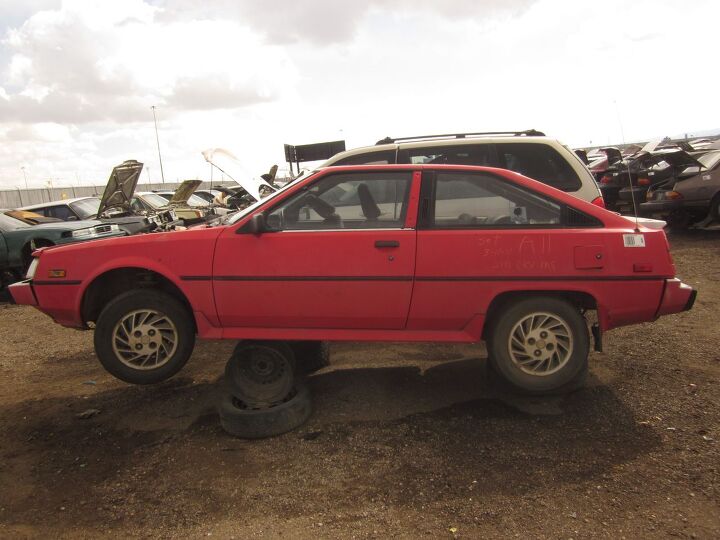Junkyard Find: What The Hell Is a Cordia Turbo?

We all remember the Starion, with its TURBO badging on everything from the seat belts to the door handles, but who among us can recall ever having seen the other 80s hot-rod Mitsubishi in the wild?
Because TURBO emblems cost extra yen, the ’87 Cordia Turbo didn’t have quite as many as the pricier Starion. In addition to the usual decklid badge, there’s the one on the steering wheel…
…and the one cast into the valve cover.
Only the 1980s could have produced this door-panel insert fabric. The Cordia (and its sedan cousin) sank into North American obscurity rather quickly. Actually, they started out in obscurity, as Mitsubishi got off to a very slow start as it tried to branch out from its captive-import relationship with Chrysler.
Check out that post-Malaise-Era 140 MPH speedometer! 1987 car buyers were able to drive a new Cordia Turbo off the Mitsubishi lot for $11,329, about the same price as the naturally-aspirated Nissan 200SX hatchback. That got you 116 turbocharged horsepower… but if you went across the street to your Dodge dealer, you could get yourself a Shelby Turbo Z Daytona— with 174 screamin’ turbocharged horses— for $12,749. Worth paying nearly a grand-and-a-half more for an extra 58 ponies? Given the nowhere-near-Toyota-and-Honda build quality of Mitsubishi products at the time, you were probably much better off with the Dodge.

Murilee Martin is the pen name of Phil Greden, a writer who has lived in Minnesota, California, Georgia and (now) Colorado. He has toiled at copywriting, technical writing, junkmail writing, fiction writing and now automotive writing. He has owned many terrible vehicles and some good ones. He spends a great deal of time in self-service junkyards. These days, he writes for publications including Autoweek, Autoblog, Hagerty, The Truth About Cars and Capital One.
More by Murilee Martin
Latest Car Reviews
Read moreLatest Product Reviews
Read moreRecent Comments
- Doug brockman There will be many many people living in apartments without dedicated charging facilities in future who will need personal vehicles to get to work and school and for whom mass transit will be an annoying inconvenience
- Jeff Self driving cars are not ready for prime time.
- Lichtronamo Watch as the non-us based automakers shift more production to Mexico in the future.
- 28-Cars-Later " Electrek recently dug around in Tesla’s online parts catalog and found that the windshield costs a whopping $1,900 to replace.To be fair, that’s around what a Mercedes S-Class or Rivian windshield costs, but the Tesla’s glass is unique because of its shape. It’s also worth noting that most insurance plans have glass replacement options that can make the repair a low- or zero-cost issue. "Now I understand why my insurance is so high despite no claims for years and about 7,500 annual miles between three cars.
- AMcA My theory is that that when the Big 3 gave away the store to the UAW in the last contract, there was a side deal in which the UAW promised to go after the non-organized transplant plants. Even the UAW understands that if the wage differential gets too high it's gonna kill the golden goose.






















































Comments
Join the conversation
My fondest Mitsubishi memory is a 1977 Dodge Colt. Had the "Silent Shaft" engine, which idled very smoothly due to the balance shaft. The car also gave me the "silent shaft" when the the shaft bearings seized up and the timing belt wiped out its teeth at the crankshaft. What a marketing double entendre by those clever MMC folks.
These cars were underpowered because Mitsubishi was hesitant to spend the money to develop a DOHC engine for them. The rest of the industry was moving in that direction already and turning out cars of similar size and price with a lot more power, but Mitsubishi didn't have the funds to do it and their cars suffered because of it.